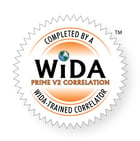Speak Agent and the WIDA ELD Standards

Speak Agent's Math+Language and Science+Language programs are WIDA-correlated. What does that mean when it comes to WIDA's 2020 Edition of the ELD Framework? This article explores the connection between the new WIDA framework and the approach that Speak Agent uses with its STEM content-language integration programs.
What is content-language integration and why is it so important? As WIDA writes, "multilingual learners develop content and language concurrently, with academic content as a context for language learning..." We share their vision for a world in which content teachers and language teachers combine their respective expertise. Sustained collaboration will prove critical to helping multilingual learners meet the rigorous academic demands of the math and science content areas.

Modes of Communication
Speak Agent operates on WIDA's stated principle that multimodality, the use of multiple means of communication, is an essential way for all students to access and engage in the content areas. Despite the name, Speak Agent is not just for speaking! In addition to spoken and written language, students also communicate through symbols, photos, animations, graphs, diagrams, maps, equations, videos, and other means. WIDA has reorganized the traditional four language domains of listening, speaking, reading, and writing in a way that actually aligns better to what Speak Agent delivers. Read on for the details...
Interpretive Communication
Interpretive communication includes listening, reading, and viewing.-
- Every Speak Agent lesson includes a variety of activities where students use active reading strategies to manipulate the text. These include the Read Along, Vocab Lab, Tall Tales, Scrambled Sentences and other activity types.
- "Viewing" is a form of visual learning where students interpret meaning from images, animations, videos, or other graphical elements. This learning mode is used extensively in Speak Agent through activities such as Word Gallery, Picture Pairs, and Matching.
- Speak Agent embeds listening in every reading and viewing activity. In addition, the My Voice activity includes a listening component along with speaking.
Expressive Communication
Expressive communication includes speaking, writing, and representing.
- Every Speak Agent lesson has a speaking activity. Students use My Voice to repeat vocabulary or to answer open-ended questions. Or they may be asked to describe how a process works in the Diagram It! activity or explain a scientific conclusion in Science Notebook.
- "Representing" is a form of visual expression where students communicate using graphical elements. The Math Puzzle Maker and Science Notebook activities in Speak Agent use this communication mode to create problems, models, or record observations, in addition to writing.
- Speak Agent provides many scaffolded writing opportunities in a variety of formats. There are short answer prompts on every page of the Read Along texts. Explain Your Work engages students in sentence stems and comparison against a writing model before having them write their own explanation. Math Puzzle Maker has students create word problems for classmates to solve. And Science Notebook has them writing hypotheses, claims, and conclusions.
Tracking and Reporting
All of the instructional activities in Speak Agent track listening, speaking, viewing, reading, and writing modes of communication, both in the aggregate as well as for each relevant math or science term. This feeds into lesson, class, and school progress reports and analyses for the benefit of both teachers and learners.Key Language Uses
WIDA has added an interesting new concept called "Key Language Uses" to its standards framework. The four uses are Narrate, Inform, Explain, and Argue. All four are present in every subject at every grade level. Here's a quick summary:
- Narrate: conveys experiences through stories.
- Inform: conveys factual information by describing, comparing, contrasting, and categorizing ideas or phenomena.
- Explain: expresses knowledge about how things work or why things happen.
- Argue: supports claims, ideas, or solutions using evidence and reasoning.
Now let's explore how Speak Agent supports the four language uses. This support is in every nook and cranny of the platform!
Narrate
In Speak Agent, students process and produce STEM stories to illustrate math and science concepts, provide useful context, make connections to the real world, adding meaning to abstract laws and phenomena, share observations about how things work and change, and to generate interest in math and science careers.
Inform
In Speak Agent, students process and produce STEM information to ask and answer questions, explore possible solutions, create and test models, represent concepts or processes, and to engage in problem-solving. They do this through multimodal texts, diagrams, and reports.
Explain
In Speak Agent, students process and produce explanations to express their knowledge about how they arrived at a solution or conclusion, how they identified errors in a chain of reasoning, how an underlying cause resulted in an effect, or to draw upon evidence-based models or proofs.
Argue
In Speak Agent, students process and produce arguments to evaluate the validity of evidence or hypotheses, design solutions, analyze errors in reasoning or solution steps, and to test and revise claims.
